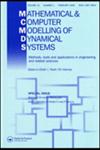一种增强垂直油井钻柱流体阻力模拟的实验验证方法
IF 1.8
4区 数学
Q3 COMPUTER SCIENCE, INTERDISCIPLINARY APPLICATIONS
Mathematical and Computer Modelling of Dynamical Systems
Pub Date : 2022-11-12
DOI:10.1080/13873954.2022.2143531
引用次数: 2
摘要
油井钻井液流动对钻柱产生粘滞力和水动力。在大多数钻柱模型中,这种影响被忽略或视为常数。本文介绍了可用于集总分段钻柱模型的横向振动阻尼力和轴向阻力的数学模型。首先,识别出钻井液生成力最敏感的变量,并应用响应面法设计实验矩阵;横向减振实验采用缩小物理模型进行验证,轴向阻力实验采用流固耦合仿真进行验证。对结果进行统计分析以获得模型,并在使用牛顿-欧拉公式和身体固定坐标开发的三维集总段键图中实现。结果表明,阻尼和轴向阻力的延长处理对弯矩波动、井筒相互作用和钻头重量有相当大的影响。本文章由计算机程序翻译,如有差异,请以英文原文为准。
An experimentally-verified approach for enhancing fluid drag force simulation in vertical oilwell drill strings
ABSTRACT The oilwell drilling fluid flows cause viscous and hydrodynamic forces on drill strings. This effect is ignored or treated as a constant in most drill string models. The present study introduces mathematical models for lateral vibration damping and axial drag forces that are employable in lumped segment drill string models. First, the variables to which drilling fluid-generated forces are most sensitive were identified and the Response Surface Method was applied to design the experiment matrix. The lateral vibration-damping experiments, which were validated using a scaled-down physical model, and the axial drag experiments were done using Fluid-Structure Interaction simulations. The results were statistically analysed to acquire the models and were implemented in a 3D lumped segment bond graph developed using the Newton-Euler formulation and body-fixed coordinates. The results indicate a considerable effect of the extended treatment of damping and axial drag on bending moment fluctuation, wellbore interactions, and weight on bit.
求助全文
通过发布文献求助,成功后即可免费获取论文全文。
去求助
来源期刊
CiteScore
3.80
自引率
5.30%
发文量
7
审稿时长
>12 weeks
期刊介绍:
Mathematical and Computer Modelling of Dynamical Systems (MCMDS) publishes high quality international research that presents new ideas and approaches in the derivation, simplification, and validation of models and sub-models of relevance to complex (real-world) dynamical systems.
The journal brings together engineers and scientists working in different areas of application and/or theory where researchers can learn about recent developments across engineering, environmental systems, and biotechnology amongst other fields. As MCMDS covers a wide range of application areas, papers aim to be accessible to readers who are not necessarily experts in the specific area of application.
MCMDS welcomes original articles on a range of topics including:
-methods of modelling and simulation-
automation of modelling-
qualitative and modular modelling-
data-based and learning-based modelling-
uncertainties and the effects of modelling errors on system performance-
application of modelling to complex real-world systems.

 求助内容:
求助内容: 应助结果提醒方式:
应助结果提醒方式:


